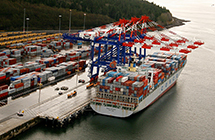 |
 |
|
| eNews • May 2017 | ||
| Promoting a Cost-Effective, Reliable and Competitive Transportation System |
||
 British Columbia ports expand to attract more US cargo
British Columbia ports expand to attract more US cargo
The British Columbia ports of Vancouver and Prince Rupert are increasing their terminal capacity and improving their cargo-handling efficiency as they look to take additional market share from US West Coast ports.
The Canadian Pacific Coast ports already have a record of success in attracting Asian imports that historically moved through the Northwest Seaport Alliance, Oakland, and Los Angeles-Long Beach to the Midwest.
Prince Rupert, with direct intermodal service to Chicago, Memphis, and New Orleans via Canadian National Railway, was designed from the day it opened in October 2017 as a gateway for both countries, and about two-thirds of its volume moves to or from the United States.
Vancouver for much of its history was content to be Canadaââ¬â¢s Pacific Coast port, and as recently as 2008 only 7.5 percent of its volume was US cargo, according to a study by Ocean Shipping Consultants. With Canada being a mature market, however, Vancouver has been making a strong play for US cargo, and by 2013, the report stated, 22.9 percent of its container volume was US cargo. A more recent report by Robert Leachman, University of California professor of industrial engineering, stated that the British Columbia port handles 4.4 percent of total US containerized imports from Asia.
The only restriction to further penetration of the US market it seems is that Vancouver and Prince Rupert are bumping up against their physical capacity. Vancouver, with an estimated annual capacity of 3.7 million TEU, handled 2.9 million laden and empty TEU in 2016. Prince Rupert, with a listed capacity of 850,000 TEU, handled approximately 800,000 TEU last year.
Prince Rupert is taking the lead in expanding its physical capacity. The port, located 500 miles north of Vancouver, in August will officially open its second container berth, Marketing Manager Brian Friesen said. It will increase Prince Rupertââ¬â¢s capacity to 1.3 million TEU. Although no new liner services have committed, Friesen said: ââ¬Å"There is a lot of interest in Prince Rupert.ââ¬Â
Vancouver is pursuing several expansion projects at existing facilities, as well as a longer-term plan to build a new container terminal at Roberts Bank that will have capacity of 2.4 million TEU, with estimated completion in the mid-2020s.
The British Columbia ports have a price advantage over their US counterparts in serving the large Midwest market. Factoring in cheaper intermodal rail rates to Chicago, terminal-handling costs, and the merchandise-processing fee on imports at US ports, the cost of moving a container from Asia through Vancouver can be $600 less than shipping through a US West Coast port, according to the Ocean Shipping Consultants study.
Railroads donââ¬â¢t talk about pricing, but industry sources say the intermodal rate to Chicago via the Canadian railroads can be $300 to $400 per container less than what the US railroads charge. West Coast port executives say they have raised this issue with BNSF Railway and Union Pacific Railroad, without results.
The report by British consultants Andy Penfold and Dean Davison, which was performed on behalf of the port of Vancouver, said further expansion of the port must involve continued cooperation between the port authority and the Canadian railroads. ââ¬Å"The business is almost entirely rail driven,ââ¬Â they stated.
The report, however, also emphasized that Vancouver operates efficiently, a point that has been stressed by Peter Xotta, the portââ¬â¢s vice president of planning and operations. He has cited Vancouverââ¬â¢s average gate time for trucks of 40 minutes compared, for example, to gate times in Los Angeles-Long Beach, which the Harbor Trucking Association said in its monthly reports average about 85 to 87 minutes.
This lesson isnââ¬â¢t lost on the US ports. John Wolfe, executive director of the Northwest Seaport Alliance of Seattle and Tacoma, said the ports are doubling down on productivity-enhancing measures that include physical infrastructure improvements and operational enhancements orchestrated through the port authorityââ¬â¢s operations center. The center houses a team of supply chain specialists in areas including vessel, terminal, labor, rail, and trucking.
Enhancing productivity is a priority at most North American ports today following the April 1 launch of the three global vessel-sharing alliances and the ever-increasing size of ships the carriers are deploying to the major gateways. In terms of capacity, Prince Rupert will be served by one string where the vessels are larger than before and another where the ships are somewhat smaller, so the net result will be no significant change, Friesen said.
Prince Rupert has three weekly services from Asia, two operated by the Ocean Alliance, with Cosco Shipping as the lead carrier, and the third by the 2M Alliance of Maersk and Mediterranean Shipping Co. OOCL will take some slots with the Ocean Alliance and it will be the newest line with a presence in Prince Rupert.
The port also is receiving three new super-post-Panamax cranes for its new berth, which will allow it to handle mega-ships holding containers 25 rows wide. The new berth also will have direct access to the on-dock rail operation that receives two inbound trains each day and sends two trains outbound for 14 intermodal train calls each week. Prince Rupert markets its on-dock railyard and the ability to handle 10,500-foot-long trains as providing a significant boost to the efficiency of its intermodal exchanges.
Prince Rupert in recent years has been attracting more outbound shipments, which will grow further this summer with the opening of an agricultural export facility on a 10-acre site on Ridley Island. Ray-Mont Logistics is building the facility, which will load into marine containers a variety of export crops including pulses, cereals, lentils, peas, soybeans, flax, and wheat. The agricultural products will arrive by rail and truck from western and central Canada and the US Midwest, Friesen said.
Source: Journal of Commerce
Soy Transportation Coalition |
|
